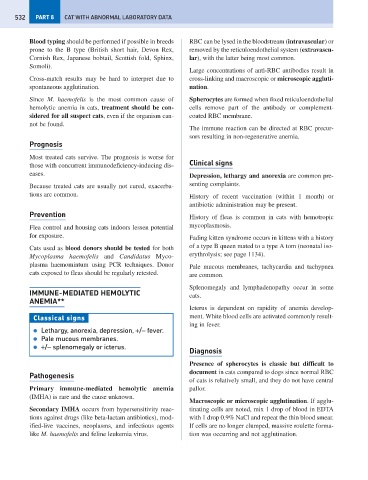Page 540 - Problem-Based Feline Medicine
P. 540
532 PART 8 CAT WITH ABNORMAL LABORATORY DATA
Blood typing should be performed if possible in breeds RBC can be lysed in the bloodstream (intravascular) or
prone to the B type (British short hair, Devon Rex, removed by the reticuloendothelial system (extravascu-
Cornish Rex, Japanese bobtail, Scottish fold, Sphinx, lar), with the latter being most common.
Somoli).
Large concentrations of anti-RBC antibodies result in
Cross-match results may be hard to interpret due to cross-linking and macroscopic or microscopic aggluti-
spontaneous agglutination. nation.
Since M. haemofelis is the most common cause of Spherocytes are formed when fixed reticuloendothelial
hemolytic anemia in cats, treatment should be con- cells remove part of the antibody or complement-
sidered for all suspect cats, even if the organism can- coated RBC membrane.
not be found.
The immune reaction can be directed at RBC precur-
sors resulting in non-regenerative anemia.
Prognosis
Most treated cats survive. The prognosis is worse for
Clinical signs
those with concurrent immunodeficiency-inducing dis-
eases. Depression, lethargy and anorexia are common pre-
Because treated cats are usually not cured, exacerba- senting complaints.
tions are common. History of recent vaccination (within 1 month) or
antibiotic administration may be present.
Prevention History of fleas is common in cats with hemotropic
Flea control and housing cats indoors lessen potential mycoplasmosis.
for exposure. Fading kitten syndrome occurs in kittens with a history
Cats used as blood donors should be tested for both of a type B queen mated to a type A tom (neonatal iso-
Mycoplasma haemofelis and Candidatus Myco- erythrolysis; see page 1134).
plasma haemomintum using PCR techniques. Donor Pale mucous membranes, tachycardia and tachypnea
cats exposed to fleas should be regularly retested. are common.
Splenomegaly and lymphadenopathy occur in some
IMMUNE-MEDIATED HEMOLYTIC cats.
ANEMIA**
Icterus is dependent on rapidity of anemia develop-
Classical signs ment. White blood cells are activated commonly result-
ing in fever.
● Lethargy, anorexia, depression, +/- fever.
● Pale mucous membranes.
● +/- splenomegaly or icterus.
Diagnosis
Presence of spherocytes is classic but difficult to
document in cats compared to dogs since normal RBC
Pathogenesis
of cats is relatively small, and they do not have central
Primary immune-mediated hemolytic anemia pallor.
(IMHA) is rare and the cause unknown.
Macroscopic or microscopic agglutination. If agglu-
Secondary IMHA occurs from hypersensitivity reac- tinating cells are noted, mix 1 drop of blood in EDTA
tions against drugs (like beta-lactam antibiotics), mod- with 1 drop 0.9% NaCl and repeat the thin blood smear.
ified-live vaccines, neoplasms, and infectious agents If cells are no longer clumped, massive roulette forma-
like M. haemofelis and feline leukemia virus. tion was occurring and not agglutination.

